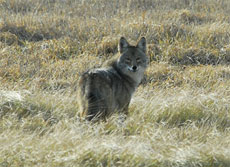Coyotes key to keeping goose population in check
 |
| A male coyote at Eola and Batavia Roads on Dec. 28, 2006. |
Coyotes and geese are among the most visible wildlife species on our site, and they have the potential to interact with humans in a regular and significant way that can have implications far beyond Fermilab.
The control of goose populations has become a growing issue in suburbs as a proliferation of detention and retention ponds has attracted larger, often year-round flocks.
A study on the relationship between coyote predation of geese and goose population control in urban areas was done in part at Fermilab by Justin Brown, of Max MacGraw Wildlife Foundation in Dundee, as his master's thesis at The Ohio State University. This look at the dynamics of urban populations of Canada geese and coyotes was conducted at Fermilab in 2004 and 2005 through the NERP program.
As recently as 1978, Fermilab imported Canada geese to the site. On the other hand, during the mid-1990s, coyote populations were depleted, owing primarily to an epidemic of sarcoptic mange.
Current estimates of Canada geese numbers are in the thousands, and coyotes now number between 15 and 20. Brown discovered that the primary means by which coyotes prey on geese is through hunting out their nests, which results in roughly 75 percent of all Canada goose egg mortality. There is also a strong suggestion that during the nesting season, coyotes may shift their territories somewhat to take advantage of goose nests.
Brown examined the question of whether this behavior has any real effect on the growth of the goose population. His model of goose population dynamics shows that the current net birth rate for geese is 1.055. However, if coyote predator behavior is statistically removed from the model, the birth rate jumps to 1.255. To put these numbers in perspective, the first population size would double in 13 years, but the second (without coyote intervention) would double in just 3.6 years.
The important lesson here is that species interact in ways that profoundly affect each other. Even though some people might not especially admire coyotes, or may actually fear them, they play an important and vital role in the overall functioning of the community.
-- Rod Walton, Fermilab ecologist
Safety Tip of the Week Archive |